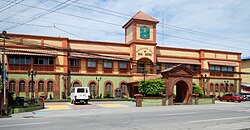San Isidro, Nueva Ecija
San Isidro | |
|---|---|
| Municipality of San Isidro | |
 Municipal Hall | |
 Map of Nueva Ecija with San Isidro highlighted | |
Location within the Philippines | |
| Coordinates: 15°18′35″N 120°54′25″E / 15.3097°N 120.9069°E | |
| Country | |
| Region | Central Luzon |
| Province | Nueva Ecija |
| District | 4th District |
| Barangays | 9 (see Barangays) |
| Government | |
| • Type | Sangguniang Bayan |
| • Mayor | Cesario Lopez Jr. |
| • Electorate | 33,813 voters (2022) |
| Area | |
| • Total | 56.49 km2 (21.81 sq mi) |
| Population (2020 census)[3] | |
| • Total | 54,372 |
| • Density | 960/km2 (2,500/sq mi) |
| Time zone | UTC+8 (PST) |
| ZIP code | 3106 |
| PSGC | |
| IDD : area code | +63 (0)44 |
| Income class | 2nd municipal income class |
| Revenue (₱) | ₱ 181.6 million (2020) |
| Native languages | Kapampangan Tagalog Ilocano |
San Isidro, officially the Municipality of San Isidro, is a 2nd class municipality in the province of Nueva Ecija, Philippines. According to the 2020 census, it has a population of 54,372 people.[3]
The town is bounded by Gapan City to the east, the municipalities of San Leonardo and Jaen to the north, San Antonio to the west, Cabiao to the south-west, San Miguel, Bulacan, to the southeast and Candaba, Pampanga, to the south.
San Isidro became the capital of the Philippines while Emilio Aguinaldo was trying to escape from the Americans.
Barangays
San Isidro is divided into 9 barangays.
- Alua
- Calaba
- Malapit
- Mangga
- Poblacion
- Pulo
- San Roque
- Sto. Cristo
- Tabon
History
San Isidro was the capital of Nueva Ecija from 1852 to 1912.[4] In 1896, the first cry against the Spanish colonial government was made. 2,000 revolutionaries under General Mariano Llanera sieged San Isidro.[5]
In March 29, 1899, General Emilio Aguinaldo declared San Isidro as the capital of the Philippines[4] after the revolutionary capital Malolos, Bulacan was captured by the Americans; this, however, was short-lived. It was also in San Isidro that General Frederick Funston planned the capture of Aguinaldo to end the Philippine-American War.[citation needed] San Isidro Central School
The Wright Institute, established in 1903 in San Isidro, was the first high school established outside Manila during the American period.[5]
The town was occupied by Japanese troops in 1942, during the second world war. The combined U.S. and Philippine Commonwealth ground forces liberated San Isidro and defeated the Japanese forces in 1945 during the end of the war.[citation needed]
Demographics
|
| ||||||||||||||||||||||||||||||||||||||||||||||||
| Source: Philippine Statistics Authority[6][7][8][9] | |||||||||||||||||||||||||||||||||||||||||||||||||
Religion
Majority of populace is Roman Catholic. Other religious groups have churches and places of worship.
Economy
Primarily depends on rice & vegetable farming, poultry and piggery.
Attractions
- Carron Dreampark is an amusement & theme park in Barangay Sto. Cristo, and was opened on November 17, 2017.
- JF Sports Complex & Resort in Barangay Poblacion.
Education
- Nueva Ecija University of Science and Technology, San Isidro Campus: started as a vocational course at the Wright Institute in San Isidro, Nueva Ecija where young Filipinos were trained in woodworking and basic telegraphy. This vocational course lasted until S.Y. 1927-1928 when the general secondary education course was transferred to Cabanatuan City. On June 9, 1929, the school was renamed Nueva Ecija Trade School (NETS) in accordance with Vocational Education Act 3377 of 1929. The NETS was based in San Isidro, Nueva Ecija, offering vocational opportunities to the youth of the province. The first and only vocational course being offered then was woodworking. That course was an addition to the existing secondary curriculum inherited from the Wright Institute.
- General de Jesus College: formerly known as General de Jesus Academy, is a private school located in the Poblacion, San Isidro, Nueva Ecija, the Philippines. It was founded in 1946.
- Holy Rosary Colleges Foundation: private school at Calaba, San Isidro, N.E.
Images
-
San Isidro Labrador Church
-
M.R.P.F. Paulino Escalada 1836 bells
-
Central Park
-
Barangay Malapit Hall
-
Nueva Ecija University of Science and Technology
-
The Crispulo Sideco (also known as Kapitang Pulong) house was built in the 19th century. Built in the Floral period in the Philippine colonial architecture, ogee arches, filigreed wooden panels, grilles wrought in curlicues and floral and foliate designs abound in the house as basic structural elements or as ornaments.
References
- ^ Municipality of San Isidro | (DILG)
- ^ "Province: Nueva Ecija". PSGC Interactive. Quezon City, Philippines: Philippine Statistics Authority. Retrieved 12 November 2016.
- ^ a b Census of Population (2020). "Region III (Central Luzon)". Total Population by Province, City, Municipality and Barangay. Philippine Statistics Authority. Retrieved 8 July 2021.
- ^ a b Navasero, Mandy (29 September 2001). "Mayor Sonia Lorenzo and historic San Isidro". Philippine Daily Inquirer. Retrieved 20 January 2016.
- ^ a b "San Isidro History". Official Website of Municipal Government of San Isidro, Nueva Ecija. San Isidro, Nueva Ecija Municipal Government. Retrieved 20 January 2016.
- ^ Census of Population (2015). "Region III (Central Luzon)". Total Population by Province, City, Municipality and Barangay. Philippine Statistics Authority. Retrieved 20 June 2016.
- ^ Census of Population and Housing (2010). "Region III (Central Luzon)" (PDF). Total Population by Province, City, Municipality and Barangay. National Statistics Office. Retrieved 29 June 2016.
- ^ Censuses of Population (1903–2007). "Region III (Central Luzon)". Table 1. Population Enumerated in Various Censuses by Province/Highly Urbanized City: 1903 to 2007. National Statistics Office.
{{cite encyclopedia}}: CS1 maint: numeric names: authors list (link) - ^ "Province of Nueva Ecija". Municipality Population Data. Local Water Utilities Administration Research Division. Retrieved 17 December 2016.








